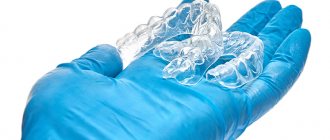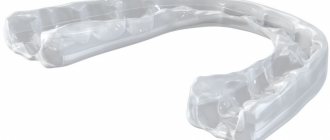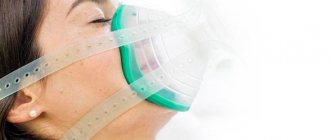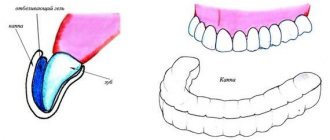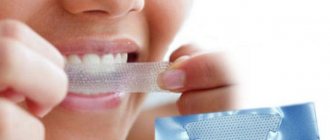Mouthguards and braces are special designs that are used to correct irregularities in the dentition. Both methods of orthodontic treatment are quite effective and each of them has its pros and cons. Let's find out how mouthguards differ from braces and what is better to choose for bite correction.
In this article
- What are mouth guards and braces: design features
- Indications
- Installation for children and adults
- Aesthetic factor
- Wearing comfort
- Rules of care
- Diet
- Duration of treatment
- Efficiency
- Price
- Braces or mouthguards - which is better?
Dental problems such as uneven teeth or misaligned bites can be treated using a variety of methods. The main ones are braces and mouth guards. The former have been used for almost 70 years, the latter began to be used relatively recently, about 15 years ago, as an alternative to orthodontic braces. What are their differences, advantages and disadvantages? These methods of teeth straightening differ in several ways:
- features of the design used;
- indications;
- installation options for children and adults;
- aesthetics;
- wearing comfort;
- rules of care;
- the need to follow a diet;
- duration of treatment;
- efficiency;
- price.
Let's look at each point separately.
What are mouth guards and braces: design features
Braces are orthodontic structures that consist of an arch and several clasps and are used to correct malocclusions. The arc has a memory effect. After installation on the teeth, it gradually returns to the original state specified during the diagnosis, and due to pressure on the jaw, it aligns the dentition and corrects the bite. There are many varieties of such structures that differ in function, strength, color, etc. However, their operating principle is the same.
Mouthguards (aligners, trainers) are orthodontic attachments made of non-oxidizing metal or polymers, used to correct the bite and acting on the principle of gentle gradual pressure on the teeth. They work exactly the same as braces. But mouthguards differ from braces in that they are lighter and invisible to others. In addition, they are removable; they are removed before eating or brushing your teeth. You cannot remove braces yourself; they are installed for several months or years.
After diagnosis, the dentist tells the patient about the advantages of each teeth straightening method and, if possible, allows him to make a choice. Based on his lifestyle, personal preferences and financial capabilities, a person determines what suits him best - braces or mouth guards.
How much does teeth straightening cost?
The price of teeth straightening is perhaps the key factor that forces patients to choose a treatment method. Before you see a doctor, you should compare the prices of different clinics and find out how much this or that dentistry asks for teeth straightening, what methods it uses, and for which procedures you will have to pay extra separately. It must be remembered that prices for teeth straightening for adults may be higher than for similar services for teenagers.
The iOrtho clinic network provides high-quality services for correcting malocclusion with Invisalign aligners, sign up for a consultation now!
Indications
Braces are prescribed more often because mouthguards as a treatment method include a small list of indications. They are unable to correct serious defects.
They are used to eliminate:
- diastema and three between teeth;
- teeth twisted by more than 6 mm;
- rotation of teeth - rotation around its axis;
- pathological inclination of dental units;
- open, distal, mesial and crossbite.
However, mouthguards are not suitable in cases where molars or canines are rotated, as well as in cases of posterior bite pathology.
With the help of braces, you can get rid of almost any anomaly associated with the incorrect placement of teeth. Orthodontic braces are indispensable for:
- crowded teeth;
- defects of jaw development;
- restoration of dental density;
- complex malocclusion pathologies, for example, dystopia.
Thus, braces are suitable for the treatment of all malocclusion pathologies. Mouth guards can be used as an alternative to orthodontic braces for minor defects.
Aligners for straightening teeth, which are offered at Dial-Dent
The technology for correcting malocclusion without braces is developing rapidly. Many companies (there are about 10 of them on the market) offer cooperation to our doctors. We have selected the best systems for correcting bites:
| Cost of treatment, including equipment | |
| Invisalign (Invisalign) | 3D Smile |
| 350,000 rub. | 250,000 rub. |
Make an appointment by phone +7-499-110-18-01 or through the form on the website. You can ask questions to the chief physician of the clinic, Sergei Vladimirovich Tsukor, on his page on
Installation for children and adults
Braces can be installed on molars at almost any age. The dental system in humans is formed until approximately 17-18 years of age, and the final bite is formed by 12-14 years of age. It is best to get braces during adolescence, as children's dental tissues are more pliable. Staples are also effective in treating adults, but preparation for their installation will require more time and effort. In addition, the healing process will be longer.
Trainers can also be prescribed to both young patients, even those with baby teeth, and older ones. However, it is worth considering that mouth guards are a removable device. If an adult can control himself, then the child will have to be constantly monitored so that he does not remove the aligners if discomfort occurs.
Typically, plates are used when the child’s molars are just erupting, if there is a risk of their improper growth. After the bite is formed, it is better to install braces. As for adults, their choice is determined primarily by indications, and only then by their own preferences.
Differences and similarities between retention and corrective aligners
Elastic pads used for correction actually replace braces, performing an identical task, but at the same time allowing the patient to periodically remove the product for hygienic care and treatment of the enamel coating. Such products are called aligners, and demonstrate effectiveness in the treatment of minor and moderate defects. The materials used for the manufacture of orthodontic correctors are distinguished by their biological compatibility with body tissues and aesthetic appearance, which is determined by their colorless structure.
In turn, removable aligners used during the retention period have different functional tasks from aligners. In the first case, the task of the product is to create a constant directed impact on incorrectly positioned teeth, allowing the formation of an aesthetically attractive smile, while retention guards are designed to maintain the already achieved position of the units.
However, there are similar aspects - the models are just as easy to use and do not cause any discomfort. The smooth surface of the structures prevents damage to mucous tissues and the development of inflammatory or pathological processes. Installation and removal do not require medical intervention - the patient has the right to make independent decisions, while not forgetting the orthodontist’s recommendations. Adaptation to the device takes several days, especially since the patient develops the habit of having a third-party device in the oral cavity while wearing braces. It is also worth noting that, unlike aligners, retainers do not require the manufacture of a large number of replacement sets - two or three models are enough for the entire course of treatment.
Aesthetic factor
Many people, especially children, are embarrassed to wear braces, have complexes and hide their smile during communication. This has a very negative impact on self-esteem and building relationships with other people. However, orthodontic structures looked unaesthetic 10-20 years ago. Today, even metal structures are very neat and do not spoil the appearance. In addition, you can order ceramic or sapphire braces. They cost more, but are almost invisible on the teeth. There are also lingual braces that are placed on the inside of the teeth. They are completely hidden from others.
In terms of aesthetics, mouth guards are superior to braces; they are almost invisible, as they are made of translucent materials.
Aligners: pros and cons of a new method of correcting malocclusion
Advantages of aligners:
- Almost invisible from the outside.
- Easy to care for. The patient does not have to buy a collection of additional products (brushes, wax, orthodontic toothbrush, special Superfloss thread) in order to properly clean his teeth.
- Made from hypoallergenic medical thermoplastic material, does not contain metal elements and has no sharp edges.
- They do not require a change in diet (they do not interfere with eating nuts or biting into apples), as they are removed during meals.
- They have a predictable virtual result. The treatment plan and timing become known at the diagnostic stage.
Cons of aligners:
- In some cases, they are less effective - for example, with severe skeletal abnormalities.
- They require total self-control and clear self-discipline, since they do not work “on the shelf” or “in the pocket.” They must be worn constantly according to the recommendations of the attending physician.
Wearing comfort
You need to get used to braces and mouth guards. The adaptation period after installation of orthodontic structures lasts about 5-15 days. At this time, the patient may experience discomfort and pain. In addition, there is a risk that metal structures will rub the mucous membrane, in rare cases this leads to the development of inflammation of the soft tissues. Braces also have a significant impact on diction, especially at the very beginning of wearing them. Even lingual braces cause speech distortion. Each time after tightening the arch there will be a new period of adaptation, but not as long as the first.
Mouthguards are much more comfortable, they do not rub the oral mucosa and do not lead to deterioration of diction. However, trainers significantly increase the size of the teeth, which is accompanied by mild discomfort. They usually get used to it quickly. During this period, it is important to be patient and not remove the mouth guards several times a day, otherwise the treatment will be delayed.
Time frame for bite correction
Treatment with braces is a long and painstaking process that requires periodic monitoring by a dentist. Teeth cannot move faster than 1 mm in a month.
To completely correct a broken bite, orthodontists recommend wearing the device for 1.5-2 years. Each case is individual, so if an additional defect is observed, this period increases.
Aligners are often installed after braces treatment has ended. The duration of wearing this system is approximately equal to the period of treatment with metal structures - from 8 months to 2 years. This is due to a number of factors:
- type of malocclusion;
- age of the patient – treatment will be faster for children;
- severity of jaw defects.
It should be concluded that installing mouthguards instead of berekets is possible only in rare cases. The main indication for wearing them is completion of treatment after straightening the dentition.
Rules of care
In terms of hygiene rules, mouthguards compare favorably with braces. It is easier to care for the aligners; they are removed before eating and brushing your teeth, and you need to clean them with a regular toothbrush with soft bristles. The trainers are washed with water and stored in a container. With braces everything is much more complicated. Hygienic procedures will take quite a lot of time, otherwise the risk of developing caries increases. To fully clean your teeth and braces from food debris and bacteria, you will have to devote at least 10 minutes to hygiene in the morning and evening. You also need to purchase special care products:
- toothbrush with V-shaped bristles: CURAPROX Ortho;
- brush for cleaning locks: Curaprox CPS 10, Biorepair Scovolini Interdentali Cilindrici;
- dental floss with a hard end: Mirafloss implant chx;
- disinfectant rinses: Biorepair Mouthwash;
- irrigator: Donfeel Donfeel OR-820D Compact, Revyline RL 100, Panasonic EW-1411, Revyline RL 200XL.
You should brush your teeth in the morning and evening, use a brush after every meal, and floss after eating fibrous foods. The mouthwash can be used several times a day, and irrigators - at least 2-3 times a week.
Types of mouth guards
Mouthguards are a fairly large group of dental structures. Their areas of application are quite extensive.
· Sports mouthguards. They are worn on the front teeth to protect against mechanical impact on the jaw, soft tissues of the face and cervical spine. They are made from dental silicone or biopolymers.
· Mouthguards for teeth whitening. Used for home whitening procedures.
· Orthodontic aligners. They are worn to straighten the teeth or correct the bite, and also as retainers to consolidate the results of treatment with more complex structures.
· Mouth guards for teething. They are also called trainers or LM activators. Such structures are made from silicone. Used to straighten incisors and correct jaws in children aged 6-10 years.
· Trays for applications on teeth. Used to remineralize tooth enamel. Regular procedure ensures its strengthening and complete recovery.
In addition to the technical features of the designs, mouthguards for correcting bites differ in the manufacturing method,
which significantly affects their cost.
· Standard (universal) mouthguards. They have average sizes. They are not suitable for everyone, since they do not take into account the individual characteristics of the dentition. Many patients complain of discomfort when wearing them.
· Thermoplastic mouthguards. This is a variation of standard designs. However, thanks to the special material from which they are made, such mouth guards can soften under the influence of hot water and take the shape of the dentition. In most cases, they are used to consolidate treatment results after wearing more complex dental structures, such as braces.
· Individual mouthguards. Made after taking an impression. Used to correct bite. Since such designs take into account all the structural features of the patient’s dental system, they are characterized by high wearing comfort.
Excluding the areas of application and production method, aligner trays differ in the material of manufacture.
· Polyurethane. Thin and transparent designs. Almost invisible on the teeth. They are distinguished by quick adaptation of the patient to the mouth guard and high wearing comfort. Does not affect diction. They are used to correct simple changes in the bite and position of the teeth, for example, with trema, diastema, crowding and mild malocclusion.
· Silicone. Thicker compared to polyurethane structures. While wearing them, the patient constantly feels them on the teeth. Sometimes the use of such mouth guards causes significant discomfort. Therefore, these designs are prescribed in cases where they need to be worn only at night or worn for only a few hours a day. Such mouth guards are also used to consolidate treatment results after wearing other structures.
· Biopolymer. This material is the basis for the manufacture of thermoplastic trays.
Diet
There is no need to change your diet after installing the mouthguard, since the plate is removed before eating. With braces you will have to stick to a diet. In the first days after fixing the braces, as well as after tightening the arches, you can only eat liquid food. Subsequently, you need to give up solid foods: hard meat, nuts, apples, carrots, etc. They should be ground or ground before eating. It is also necessary to limit the consumption of sweets, sticky foods and drinks with coloring substances: soda, coffee and tea.
After installing braces, it is important not only to exclude certain foods from the diet, it is also recommended to observe the temperature regime. You should not eat food that is too cold or too hot. It negatively affects the condition of the structure and enamel.
Many people mistakenly believe that braces damage teeth, since a large number of bacteria accumulate under them. However, germs can only appear under the arc, and if you take care of hygiene, they will not cause any harm. The locks themselves are sealed tightly, so neither microorganisms nor food debris can get under them. The part of the tooth to which the lock is glued, on the contrary, is reliably protected from external influences.
Alignment tray manufacturing process
The decision on the advisability of wearing mouth guards to straighten the bite is always made by the doctor, after examining the patient and performing a number of diagnostic measures. The specialist will determine the complexity of the defect, take into account the structural features of the patient’s jaws, and if no contraindications to the use of mouthguards are identified, an impression will be taken from the patient’s teeth.
The taken impression is sent to the laboratory, where it is used to model the future design. Based on the model, sets of mouth guards will be produced, which the patient will change during treatment. When the mouth guards are ready, the patient comes to the clinic again, where the design is tried on and the specialist gives detailed advice on how to properly wear and care for the mouth guards.
Duration of treatment
The duration of treatment for malocclusion pathologies using mouthguards and braces is the same. However, trainers are not installed for serious disorders, so they usually have to be worn for 8-12 months. If you get braces for exactly the same dental disease, the correction will also last about a year. Severe curvatures are corrected within 1-3 years.
The effectiveness of treatment largely depends on how the patient follows the doctor’s recommendations. If he doesn't have good hygiene while wearing braces, doesn't eat well, or (if he wears a plate) removes his mouth guard too often, complications can arise. As a result, the teeth straightening process will be delayed. In addition, you will have to pay for additional services: making a new design, caries treatment, etc.
Features of the use of mouth guards that the patient needs to know about.
Treatment planning is carried out using sophisticated computer programs that are available to the aligner manufacturer. The doctor diagnoses the patient and plans treatment. After this, the technical specifications are transferred to the manufacturer of the aligners. There are several such companies. We at Dial-Dent work with the Invisalign company (USA) and the Russian 3D Smile aligner system. In our opinion, these are the best systems.
After the manufacturer receives diagnostic data and technical specifications from the doctor, he first simulates the treatment virtually. This is a significant difference from the principles of working with braces. When starting treatment with braces, neither the patient nor the doctor has the opportunity to see the results in advance. Kappas have a huge advantage. Before treatment begins, you can watch a video showing the movement of teeth under the influence of each aligner. Both the doctor and the patient can analyze this information. The patient usually perceives this as an opportunity to see the result. And for a doctor this is the most important diagnostic tool. By analyzing the virtual plan for moving teeth, the doctor can adjust any stage of treatment and get a much better result! After finalizing the 3D plan, the manufacturer is given a command to produce transparent aligners for a specific patient. The doctor receives a mouthguard. Hands them over to the patient with instructions and then monitors the progress of treatment.
Efficiency
The effect lasts for a long time, both after braces and after mouth guards, but only if the patient follows the rules of the retention period. This is the final stage of any orthodontic treatment. After removing braces or aligners, you need to wear other mouth guards - retainers, which are slightly different from corrective ones. This device allows you to consolidate the result.
Retainers must be worn for the same period for which braces or mouth guards were installed. The fact is that after removing them, the load on the teeth is greatly reduced, so they can return to their previous position. It is necessary to strengthen the ligamentous apparatus around the tooth roots. Retainers allow teeth to adapt to new conditions.
How long should you wear mouth guards?
Each mouthguard should be worn 22-23 hours a day for 2 weeks. Accordingly, it is on the teeth at night. The mouthguard is removed from the mouth only during meals and hygiene procedures. An exception may also be an important meeting, interview, etc. It is not recommended to speed up the process (reduce the intervals between mouth guards), since, firstly, you most likely will not be able to put on a mouth guard ahead of time, and secondly, acceleration can lead to complications. The duration of treatment with aligners varies from person to person. Mild cases, for example, rotation of 1-2 teeth can be solved by wearing 5-8 aligners. Complex cases may require 30 or more aligners.
Braces or mouthguards - which is better?
So, what should you choose - mouth guards or braces to straighten your teeth? This depends on several factors, the main one being medical indications. Let us list once again the main advantages and disadvantages of braces and mouthguards.
Pros of braces:
- high efficiency;
- suitable for almost any pathology;
- relatively low cost.
Cons of braces:
- long installation;
- difficulty of care;
- unaesthetic;
- long-term adaptation.
Pros of the mouth guard:
- aesthetics;
- do not impair diction;
- no diet;
- simple hygiene rules;
- hypoallergenic.
Cons of the mouth guard:
- high cost;
- not suitable for all disorders;
- long production;
- risk of loss.
Another important factor to consider when choosing a malocclusion correction method is related to motivation. You need to prepare for the fact that after installing braces or mouth guards there will be discomfort and even pain. You need to be patient for a little while so that the oral cavity gets used to the foreign object. A person who is prescribed aligners may want to remove them. Over time, he will do this more and more often, and because of this, the effectiveness of the treatment decreases. It can last for several years without bringing any results. Braces in this context have an important advantage: they cannot be removed by yourself, so you will have to come to terms with and comply with the orthodontist’s requirements.
Indications for installation of bracket systems
Braces are required for more than just correcting malocclusion. They can also be useful for treating other serious pathologies of the oral cavity, when other methods are simply powerless. For example:
- Complex and very advanced cases of jaw deformation.
- Increased crowding of a row or, conversely, its sparseness. As a result of this pathology, the roots of the teeth can be exposed, which causes the patient severe discomfort in everyday life.
- Incorrect development of the jaw bone.
- Deep bite.
- Dystopia and so on.
Advantages and disadvantages
Of course, if braces were ineffective, they would not have been used by the most experienced orthodontists around the world for many decades. These systems demonstrate excellent results in correcting even the most complex malocclusion pathologies.
However, like any treatment method, there are pros and cons.
Main advantages:
Maximum efficiency and reliability.
Wide scope of use. Braces can be used to correct minor curvatures or in cases of serious irregularities.
During treatment, the patient regularly visits his doctor, so the entire process is carried out under the strictest control. If necessary, the doctor can make adjustments to the prescribed action plan, fix the breakdown, or give the necessary advice.
If we compare treatment with braces with the installation of mouth guards, then the cost is significantly lower. This usually plays a decisive role in the choice.
Unfortunately, braces have a number of disadvantages:
- When vestibular structures are installed, the smile loses its former attractiveness. While braces can look bulky and heavy, metal options are dark in color so they stand out against the white enamel of the tooth. As a result, a person may feel constrained and insecure when communicating with colleagues and friends.
- Manufacturing and installing the system itself takes a lot of time. Fixation takes an experienced specialist from 1 to 3 hours, depending on the complexity of each specific case.
- Non-simultaneous correction of all units in a row.
- Risk of damage and staining of enamel. As a result, white carious spots, cracks, etc. may appear.
- The braces are quite large and have sharp edges. All this can lead to accidental injury to the mucous membrane, inner surface of the cheeks and tongue. This applies to both vestibular (classical) systems and those installed on the inside of the row (lingual).
- Also, during the adaptation period (from several weeks to several months), the patient may experience diction problems.
Types of bracket systems
A lot depends on the material from which orthodontic structures are made, as well as on the method and place of their fixation. Braces are lingual and vestibular, ligature and self-ligating. Depending on the material, the following are distinguished:
- Metal. They are considered the most effective and fastest due to their strength and reliability. At the same time, they look rather awkward and cumbersome on the teeth, which attracts the attention of others. They are able to cope even with complex bite pathologies. They cost less than their analogues.
- Plastic. They look more attractive, but are less durable. Their cost is approximately the same. Children really like it, as it is possible to make colored or shaped versions.
- Ceramic. They are practically invisible on the teeth, but can become stained when drinking large amounts of strong tea, coffee or red wine. Due to the porous structure of the material, plaque accumulates more actively on them, as a result of which, even with regular cleaning, braces can lose their original appearance.
- Sapphire. The most aesthetically attractive models are made from artificially grown sapphire crystals. They are absolutely invisible on the teeth, as they are completely transparent and imitate the shade of your own teeth. Moreover, this design option is the most expensive, so not everyone can afford its installation. It is important to note that the treatment period with such braces will be longer than with metal options.
previous post
Internal braces
next entry

